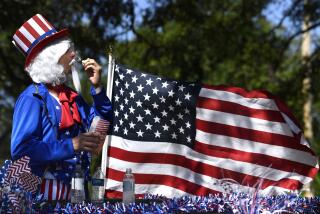In Utah, Independence Day Can’t Hold Roman Candle to Pioneer Day
- Share via
SALT LAKE CITY — Elsewhere in the country, July 24 will be business as usual. And that will make the day doubly frustrating for people like Ed Schmidt.
“I’ll have four employees sitting around with nothing to do because our customers won’t be open for business,” said Schmidt, a district manager for a national hardware distributor that--like the rest of the country--doesn’t recognize Pioneer Day as a holiday.
But for nearly 2 million others in the Intermountain West, the uniquely Western holiday, known also as the Days of ’47 or simply July 24th, has no rival.
Since Mormon settlers first celebrated their new beginning on July 24, 1849, the holiday has evolved into one of the largest regional celebrations in the United States. Even Independence Day pales in comparison--a curious fact to some historians and newcomers like Schmidt.
This year the difference will be even more pronounced as members of the Church of Jesus Christ of Latter-Day Saints mark the sesquicentennial of their pioneer ancestors’ arrival in the Great Basin on July 24, 1847.
Utahans--Mormons in particular--aren’t intentionally making a statement by letting the Fourth of July appear a warmup for a bigger bash 20 days later. Still, history and local culture offer an interesting and entertaining backdrop to seemingly rival holidays that suggest a divided loyalty.
“There is something symbolically suggestive about a people who are an indigenously developed group to have their ethnic identity be most important,” said Dean May, a University of Utah history professor. “They are attached to a new history of their faith” as well as to their country.
For decades during the 19th century, the patriotism of Mormons had been questioned. The church’s quest to leave the United States and establish “the Kingdom of God” in Mexican territory had made some national leaders suspicious.
Mormon leaders began planning the migration to the West in the early 1840s, looking for a place to practice their religion. They considered such places as Texas, Northern California, Oregon and Vancouver Island, eventually settling on the Salt Lake Valley, a place they felt would be “coveted by no other people.”
While church members are admonished to uphold the law of the land, the teachings of their leaders, who are revered as prophets, seers and revelators, take precedence. Those teachings today don’t conflict with the law, but the church’s past practice of polygamy was illegal and its communal economics and theocratic rule ran counter to the country’s established economic and political systems.
“Polygamy was the easiest sell” to whip up public opposition to Mormons, May said. “But questions about loyalty to the United States and whether Mormons could culturally conform to the country’s [democratic] systems were the main concerns.”
The church often sent mixed signals about its allegiances.
During the 1847 trek to their new home, Mormons didn’t celebrate Independence Day. But they carried an American flag with them, dispatched a battalion of volunteers to the Mexican War and petitioned the federal government to make their Great Basin empire a U.S. territory.
Meantime, federal military troops, judges and other authorities assigned to govern the territory were unwelcome, their authority frequently flouted.
During the 1886 observance of Pioneer Day, the Mormon Tabernacle was draped in black bunting and those in hiding or imprisoned by federal authorities for practicing polygamy were eulogized for their devotion to the faith.
May said he found it curious when he moved to Utah in the 1970s that the Fourth of July fireworks were launched from downtown Liberty Park, established by non-Mormons who had taken over City Hall after statehood as a symbol of the “liberation from Mormon dominance.”
For Pioneer Day, fireworks shot into the sky from Sugar House Park, the site of the old state prison where Mormon leaders were incarcerated for practicing polygamy.
Whether the location of the fireworks had any intentional meaning, May can’t say.
But any notion today that Utah’s 70% Mormon population isn’t patriotic has vanished. A July Fourth extravaganza called the Freedom Festival is held each year in Utah County, a stronghold of the ultraconservative John Birch Society.
And the common practice of one community celebrating Independence Day, while the neighboring town hosts a Pioneer Day bash, is more economics than preference. Not even Salt Lake City wants to finance two celebrations in three weeks.
“The bid for just the fireworks on the 24th is $35,000,” said Wayne Oberg, sports director with the city’s parks and recreation division.
He noted, too, that the Pioneer Day fireworks now are at Liberty Park, while Salt Lake County sponsors the Independence Day display at Sugar House Park.
More to Read
Sign up for Essential California
The most important California stories and recommendations in your inbox every morning.
You may occasionally receive promotional content from the Los Angeles Times.













